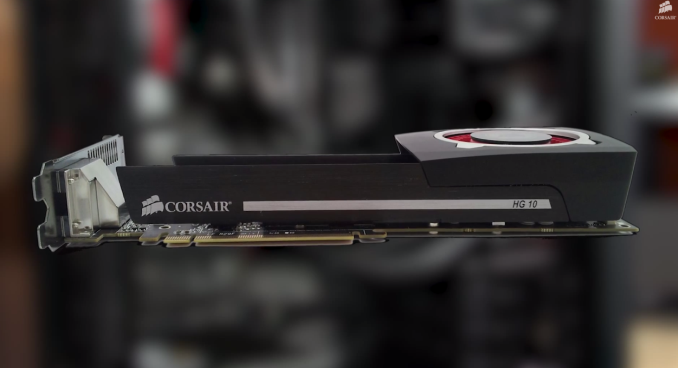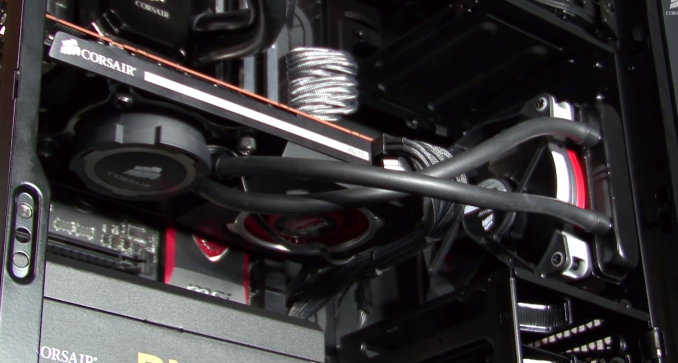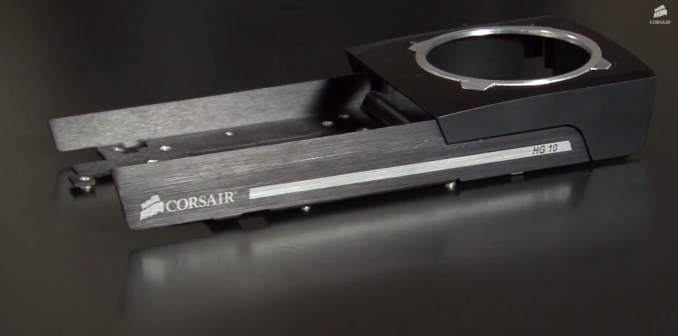Corsair Presents the Hydro Series HG10 GPU Liquid Cooling Bracket
by E. Fylladitakis on June 2, 2014 7:38 PM EST- Posted in
- Corsair
- Cases/Cooling/PSUs
- AIO
- Water Cooling
- Wacom
- Computex 2014

In its endless rampage of new product releases today, Corsair has also presented the Hydro Series HG10 GPU cooling bracket, a solution for those that want to install an all-in-one (AIO) liquid cooling kit on a graphics card. This approach is not new, as other companies have presented similar solutions (some may remember our recent review of the NZXT Kraken G10); however, such solutions would focus on the GPU core and leave the VRM and RAM with just airflow from the fan installed on the bracket, which could become a problem if the VRM heatsinks of power-hungry cards are removed alongside the stock cooler.
Corsair's press release suggests that the Hydro Series HG10 will not only cool the GPU core but the VRM and RAM chips of your card as well. This is done by keeping the stock cooler's radial fan and parts of its body, which are still being powered by the graphics card's fan control circuitry. Essentially, the HG10 seems to be replacing parts of the stock cooler in order to add support for the liquid cooler core. Compatibility wise, there are both good and bad news. The good news are that the HG10 is compatible with all of Corsair's Hydro series, from the H55 and H80 to the H100i and H110; therefore, it will most likely be compatible with the vast majority of AIO liquid cooling kits from many companies. The bad news are that it requires specific card models, limiting its compatibility with only AMD Radeon R9 290X/290 reference cards (A1 Edition) or NVIDIA GeForce Titan, 780 Ti, 780, 770 cards (N1 Edition). Corsair hinted that there will be more versions for other AMD cards soon, although they did not specify for which models.
The first versions (A1 Edition) will be available this June for $39.99.












11 Comments
View All Comments
MadHatter0 - Monday, June 2, 2014 - link
Is the N1 edition also limited to reference designs then I assume? Such limited compatibility for both of them.kyuu - Tuesday, June 3, 2014 - link
If you're going to be modifying the card with custom cooling, it seems sensible to be purchasing a reference card in the first place, no? Usually the point of non-reference cards is for their cooling solutions.H4E - Tuesday, June 3, 2014 - link
Non reference cards can vary alot, and not just cooler. I.e. different power circuits, different speed/amount ram, and quality of the components can be higher. So some cards can handle higher voltages and hopefully higher clocks, which would be easier to cool with water cooling.Antronman - Monday, June 9, 2014 - link
Not just this.OC tools like Precision X and GPU Tweak are actually really nice.
And yes, cards like the DCII line from Asus, and the EVGA classified card tend to OC much better, because of higher rated components.
adriangb - Monday, June 2, 2014 - link
so it's a no go with a GTX 760?Samus - Tuesday, June 3, 2014 - link
ditto, can't believe they're leaving out the 760 (which uses a PCB layout shared by many cards going back to the 660)my guess is they will eventually release one for the 760.
Dregdom - Tuesday, June 3, 2014 - link
Got the R9 290 so very great!Hope it supports NZXT x40 or x60!
Juni0rM1nt - Wednesday, June 4, 2014 - link
What about the 600 series; 680, 670 etc?4daone - Thursday, June 5, 2014 - link
Out of all the temp screenshots I've seen of this product in action...the vrm temps were always cut out......its comical guys....corsair....you take us for idiots?Casecutter - Monday, June 9, 2014 - link
Yea, I agree it’s all about the VRM temps and they've glossed over that. On any Red-Mod or Kraken G10 its’ been all about VRM/mosfets cooling as their shortcoming, especially if you hope to OC.I hope Corsair gave some real thought in this area, however I think this basically not much different then what a normal cards abilities for taming the VRM's/mosfets. (appears to be nothing much different/new than what the stock flat aluminum plate and thermal tape). Now it’s hard to say but due to the lower fan speed it might not be as effective. One thing it might have in its corner, is if there's less heat from the GPU its self, then less heat might radiate to the VRM's and they can stay cooler than stock.
I really want someone to review this and do with a thermal camera. Guru3d.com comes to mind as he ran the reference card that way originally.